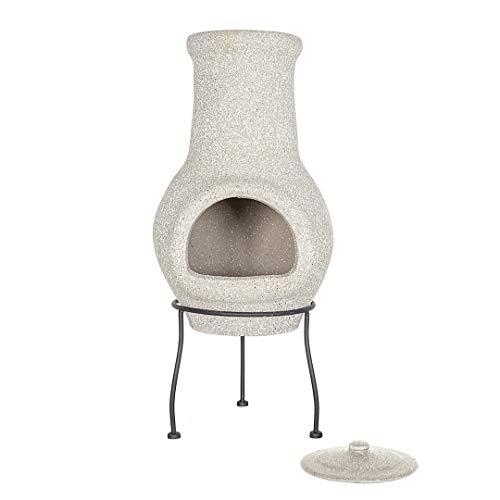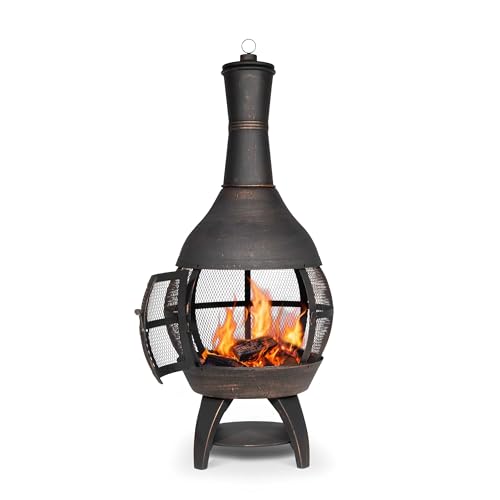14 Cartoons About Mexican Chimineas Which Will Brighten Your Day
Sophie
2024.11.18 16:18
441
0
본문
 Chimineas - An Authentic Mexican Fire Pit
Chimineas - An Authentic Mexican Fire PitThe first time they were used was as a bread oven Chimineas represent Mexico's rich cultural heritage. The simple design, blending practicality and aesthetic simplicity, is timeless.
 Chimineas of clay are fired in kilns to remove organic materials and seal the pores to reduce cracking. They are designed to live outdoors all year long, but should be protected from long-term exposure to the elements.
Chimineas of clay are fired in kilns to remove organic materials and seal the pores to reduce cracking. They are designed to live outdoors all year long, but should be protected from long-term exposure to the elements.Origins
Imagine a balmy evening in the summer, with your loved ones and family enjoying delicious food outdoors, all warmed by your Mexican or clay chiminea. This scene is reminiscent to the Mexican origins for this type of outdoor fireplace.
These traditional terracotta stoves were designed to serve as radiant heaters and ovens. They helped tribesmen survive the cold desert nights in their homeland. Their distinctive design was inspired by their utilitarian principles that emphasised practicality and shared living.
Originally these stoves were constructed of natural terra-cotta clay which was dried and wood-fired in kilns. Chimineas made of clay are more rustic in appearance and were not glazed to protect the surface. Modern manufacturers now produce chimineas from metals such as brass, cast iron and aluminum. These materials offer enhanced durability and weather resistance which addresses one of the major weaknesses of the clay design.
The distinctive design of the chiminea was inspired by a pot-bellied base that rises to an long fireplace. This shape is an ideal method of containing the flame while directing the smoke upwards, which reduces air inhalation and maximizes heat retention.
Chimineas were utilized for cooking as well as heating and lighting for the indigenous people of Mexico. We can still enjoy their aesthetics as well as the warmth they bring in the chilly autumn evenings or even in the warm winter sun.
Whether your chiminea is an authentic Mexican piece or a more modern one, Gardeco has a choice of different styles to suit your decor and garden. We have a variety of sizes, ranging from small to extra-large. We also have clay chimineas that have been decorated with either a moulded or engraved design.
Our range of terracotta-based Chimineas as well as Mexican Chimineas is made by artisans right in the heart of Mexico. The colours and shapes can vary slightly due to the nature of the manufacturing process. If your chiminea begins fade, you can always repaint it using an water-based emulsion. It is important to read the manufacturer's instructions and care guidelines prior to using your new chiminea for the first time.
Design
Chimineas are not just functional but they also add an authentic and rustic look to the space. They are available in a variety of designs and materials. They can be matched to any patio furniture. They can be a focal point or blend in seamlessly with the landscape.
The traditional chimenea, made of clay, was designed with both practical and cultural significance in mind. Its chimney-like neck was tall and directed the smoke away from its users and its rounded, rounded body radiated warmth. It also served as a center for storytelling and socializing, giving it an important role in Mexican and Central American culture.
Traditionally, chimineas were crafted by local artisans using wet clay that was taken directly from the ground. The raw material was transformed into its final form before being dried by kiln. Clay chimeneas are very labor intensive to make especially big chiminea ones. The Chiminea uk (king-wifi.win)'s neck and bowl are made by smoothing long snakes of clay rolled. The rim of the clay was often decorated with carvings and patterns.
Modern chimineas are usually constructed of metals, such as cast-iron or aluminum. The introduction of metal chimineas was a significant evolutionary step because they can withstand high temperatures and moisture without cracking. This modification allowed chimineas to be used in a variety of climates.
Metal Chimineas are most commonly used but there are some companies that produce clay and terracotta chimineas. The advantages of a metal chiminea include its capability to withstand higher temperatures as well as the fact that it is able to be cleaned more easily. These factors have made metal chimineas more popular than clay counterparts.
No matter which kind of chiminea you pick it's important to put it in the correct place. It should be positioned in a level area and away from any flammable objects like trees, grass, or other buildings. The chiminea should also be placed on a concrete, brick or stone patio, and not on a wooden deck. It's also an excellent idea to put 50mm of sand or Gardeco lava stones under the chiminea to protect it from direct heat and to keep the hot part of the fire from the clay.
Materials
Traditional chimineas made of terracotta and clay, which are still made by small factories today, are kiln fired to temperatures of up to 1000c. After they have cooled and dried, the chimineas may be put together. Some are glazed while others are left unglazed. These chimineas provide an Mexican feeling in a garden.
Chimineas are usually hand painted and come in a variety of colors and designs that can be adapted to a wide range of styles. The paint finish can fade as time passes and also due to the heat of the fire, therefore it is best chiminea to re-paint using an acrylic emulsion that is water-based.
While originally intended to be essential features for heating and cooking for town-dwelling Mexicans Chimineas have been a symbol of a sense of cultural heritage over the centuries adapting to various requirements for functional purposes. These distinctive structures were not only used by the indigenous peoples of Mexico as bread ovens, but also played a crucial role in repelling bugs and promoting social gatherings.
The unique design of the chiminea, with its wide base and narrow chimney spout permits maximum air to be drawn into the chiminea sale's bottom, minimizing the intake of smoke. It also helps retain the heat inside the chiminea, making it ideal for cooking over.
Today, chimineas can be found in various materials, including cast iron, terracotta clay and even aluminum. Terracotta Chimineas are the most common choice, offering the classic Mexican look. They are prone cracking when under pressure, and should only be placed on flat surfaces that are fire-safe. Cast iron and aluminium chimineas are less prone to cracking and damage, but they are stylish and sturdy.
To make sure the chiminea will last as long as possible, you should place it in a location which is well ventilated and protected from wind and rain. It should be placed away from any walls and structures which could catch alight as well as patio roofs or eaves that may be damaged due to the sudden change in temperature that occurs when the chiminea is extinguished. To avoid the chiminea burning excessively it is recommended that only dried, seasoned logs are burned. Regular cleaning with a wire brush is important, as it will keep deposits from accumulating that are liable to burn and blacken. Shielding the chiminea from winds will also help reduce the amount of smoke that it emits as it is burned.
Maintenance
The proper maintenance is vital to the longevity of any fire apparatus. This can extend its lifespan and also ensure that it operates safely. Chimineas can be fragile and should be kept outside where they can be properly cared for. Although a chiminea made of clay may appear to be sturdy enough, it's still vulnerable to cracks and breakage from various sources. This is why it is important to inspect your chiminea regularly for signs of wear and tear and also to follow the manufacturer's instructions regarding how often it should be fired.
To keep your mexican chimney looking good, you should clean it thoroughly using a mild detergent. This will remove any built-up dirt and grime that could cause discoloration and rust. To get rid of the rusty particles that are loose, make use of a wire brush. It is recommended that goggles and gloves are worn for safety. After you have scrubbed, wash the chiminea and allow it to dry completely. This will keep any moisture from which causes corrosion, and can prolong the life of your chiminea.
After your chiminea has been cleaned and dried, it should be lightly sanded using fine-grit the sandpaper. This will smooth out the surface and eliminate any rough spots that could catch embers if you decide to make an open flame. Sanding can also make the surface more uniform and attractive. Finally, the sanding can be followed by a series of coats of stove or grill paint, which will improve the appearance of your chiminea modern and guard it from rust.
Keep your chiminea away from direct sunlight and winds as it can cause the paint to peel off and fade. If this occurs, you can touch up the affected areas using water-based emulsion paints or masonry sprays, and it's usually easy to do. Additionally, it is important to only use small fires and to add small amounts of wood at one time to your chiminea so that you make sure it is "broken in" and to prevent overheating.

댓글목록 0